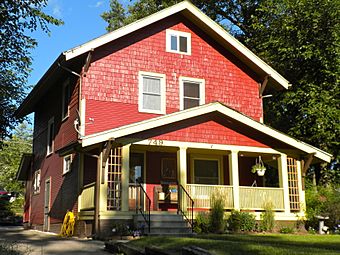Middlesex Plat Historic District facts for kids
Quick facts for kids |
|
|
Middlesex Plat Historic District
|
|
 |
|
| Location | Center St. to Woodland Ave., 31st to 35th Sts. Des Moines, Iowa |
|---|---|
| Area | 37.69 acres (15.25 ha) |
| Built | 1910-1923 |
| MPS | The Bungalow and Square House--Des Moines Residential Growth and Development MPS |
| NRHP reference No. | 00000932 |
| Added to NRHP | November 21, 2000 |
The Middlesex Plat Historic District is a special neighborhood in Des Moines, Iowa, United States. It's known for its unique homes built between 1910 and 1923. This area was once home to many families who lived in large, two-story square houses and cozy bungalows. Since 2000, this district has been recognized on the National Register of Historic Places. This means it's an important historical area worth preserving.
Contents
How the Middlesex Plat Neighborhood Grew
The Middlesex Plat area was developed a bit later than other parts of western Des Moines. This was mainly because it didn't have important things like sewer lines and streetcar routes.
Building the Infrastructure
In 1907, the Ingersoll Run sewer line was finally finished. This brought modern plumbing to northwest Des Moines. Also, streetcar lines were extended into the area around the same time. Before this, the closest streetcar was quite a distance away.
Who Owned the Land?
Another reason for the delay was that a person named J. Callanan owned the land. He chose not to sell it for building homes in the late 1800s. Most of the houses you see in the district today were built between 1910 and 1923.
Developing the Area
People who wanted to develop the area worked hard to make sure it grew well. They kept their promises to those who bought land and to the builders. Important people like realtor Winner and Kauffman, and builders Henry Tillia and Charles Barnes, helped shape this neighborhood.
Exploring the Architecture of Middlesex Plat
The Middlesex Plat Historic District is famous for its many square houses and bungalows. These homes come in different styles. Out of 293 properties, 187 are houses. Only a few of these houses are not considered historic because they were built recently or changed a lot. The district also has 106 separate garages. Many of these garages are also considered historically important.
Square Houses: A Popular Style
Square houses are more common in the district than bungalows. Most of these square homes have a roof that slopes down from the front. They also feature a wide front porch. Many were built between 1910 and 1916. A few more were built up until 1923.
Another type of square house has a roof that slopes down from the side. The most popular year for building this style was 1910. A few of these homes were built each year until 1925. There are also a few American foursquare houses. These homes have a low, pyramid-shaped roof. Most of them were built before 1911.
Bungalows: Cozy and Unique Homes
Most bungalows in the district have a front roof that slopes down. They often have a front wing with a roof that connects to the main roof. Many of these were built after 1918.
Some bungalows have a front porch with a sloped roof, and a side porch with a sloped roof too. Others have a sloped front roof with a parallel sloped front porch. There are also "airplane bungalows." These are single-story homes with a second-story room that looks like it's "pushed up" through the roof.
A few bungalows have a sloped front roof with a porch that is set back. Only one bungalow has a pyramid-shaped roof. The remaining bungalows have a side-sloping roof. Many of these have a wide front porch. They were built from 1910 to 1921. Some bungalows also show influences from the American Craftsman or Colonial styles.
Other Architectural Styles and Garages
A small number of houses in the district follow other styles. These include Tudor Revival, Colonial Revival, or Prairie Style.
Most garages in the district are not considered historic. This is because they were built after the main period of development. There are no alleys in the neighborhood, and the narrow lots also made it hard to build garages. Some garages are attached to the houses, and others are built into the basement.



